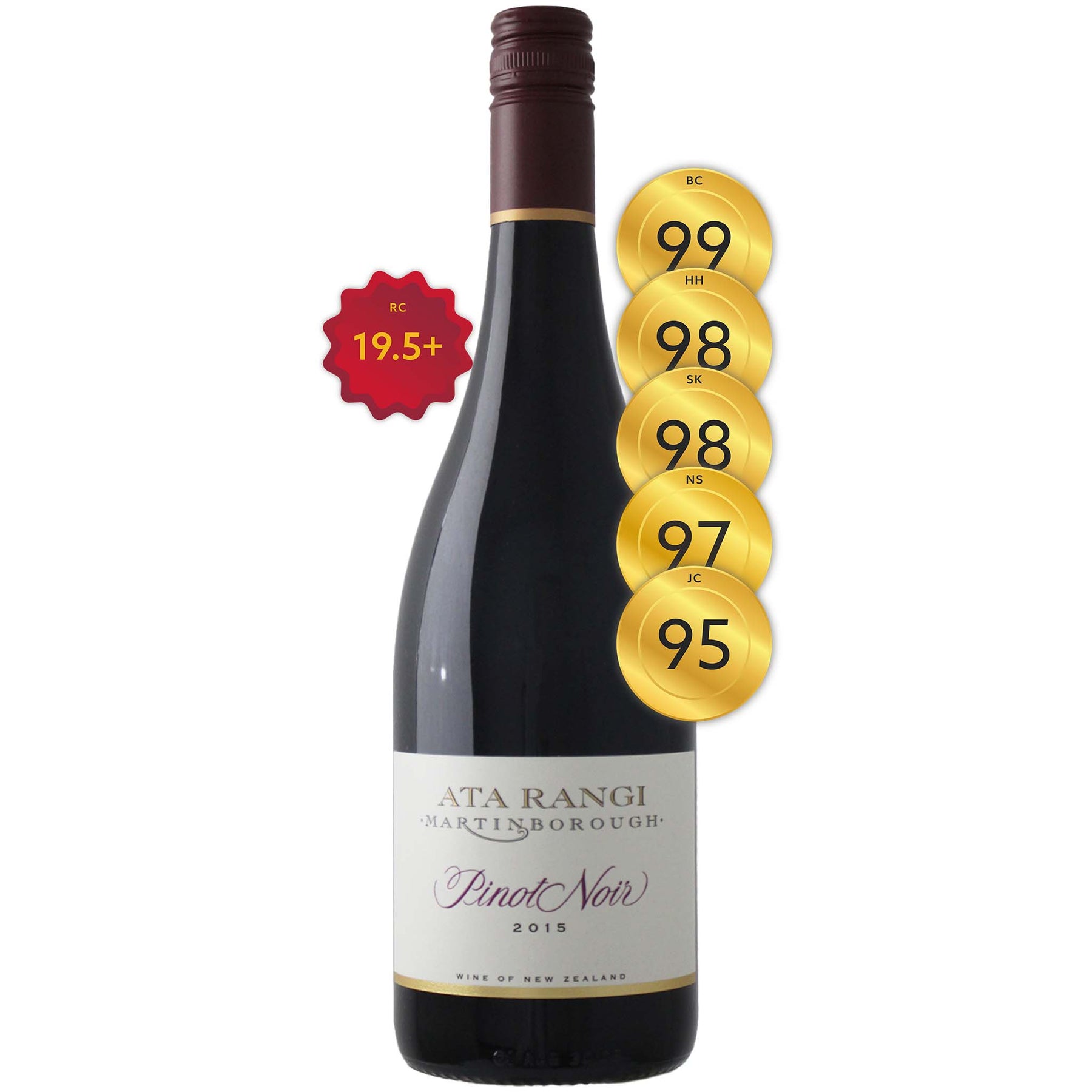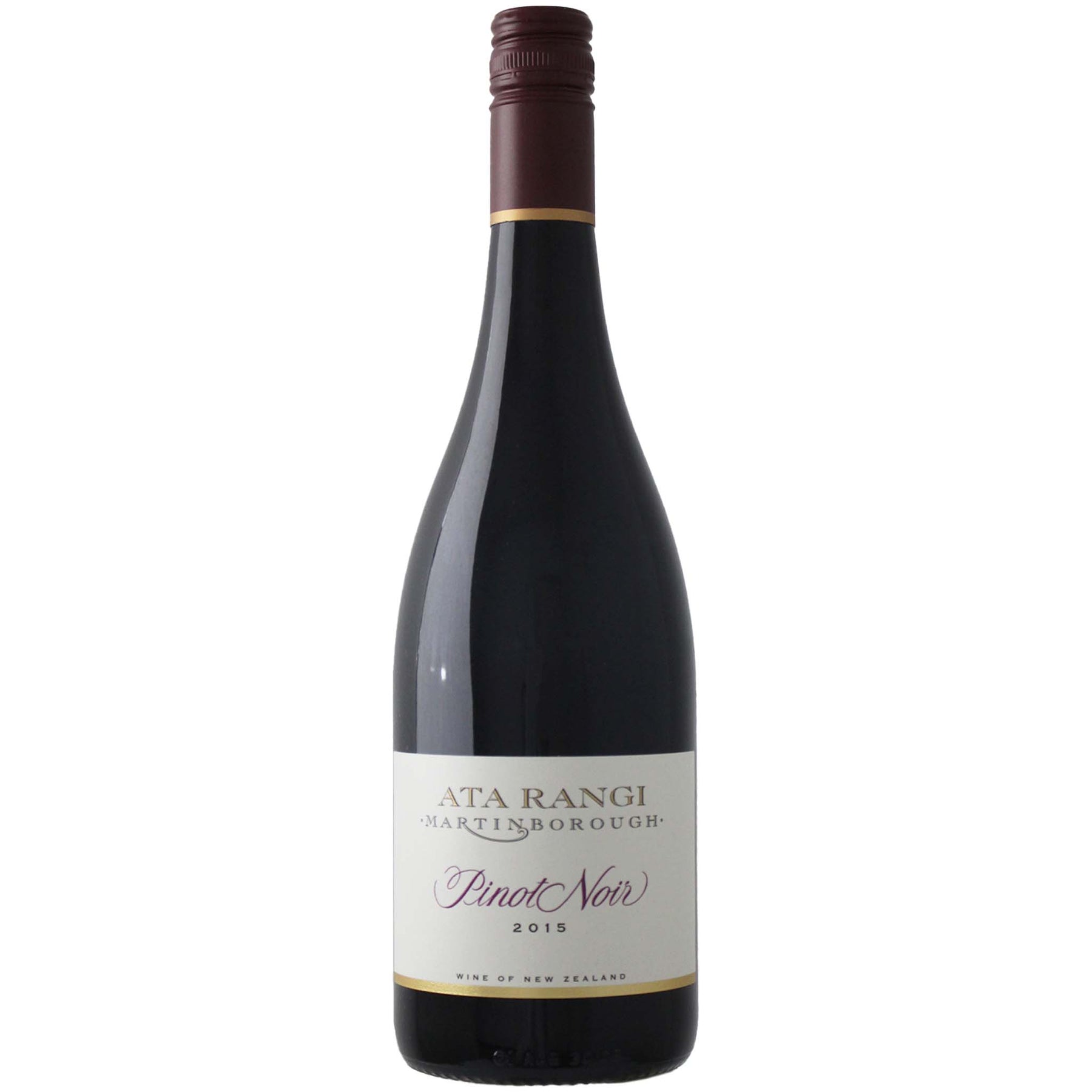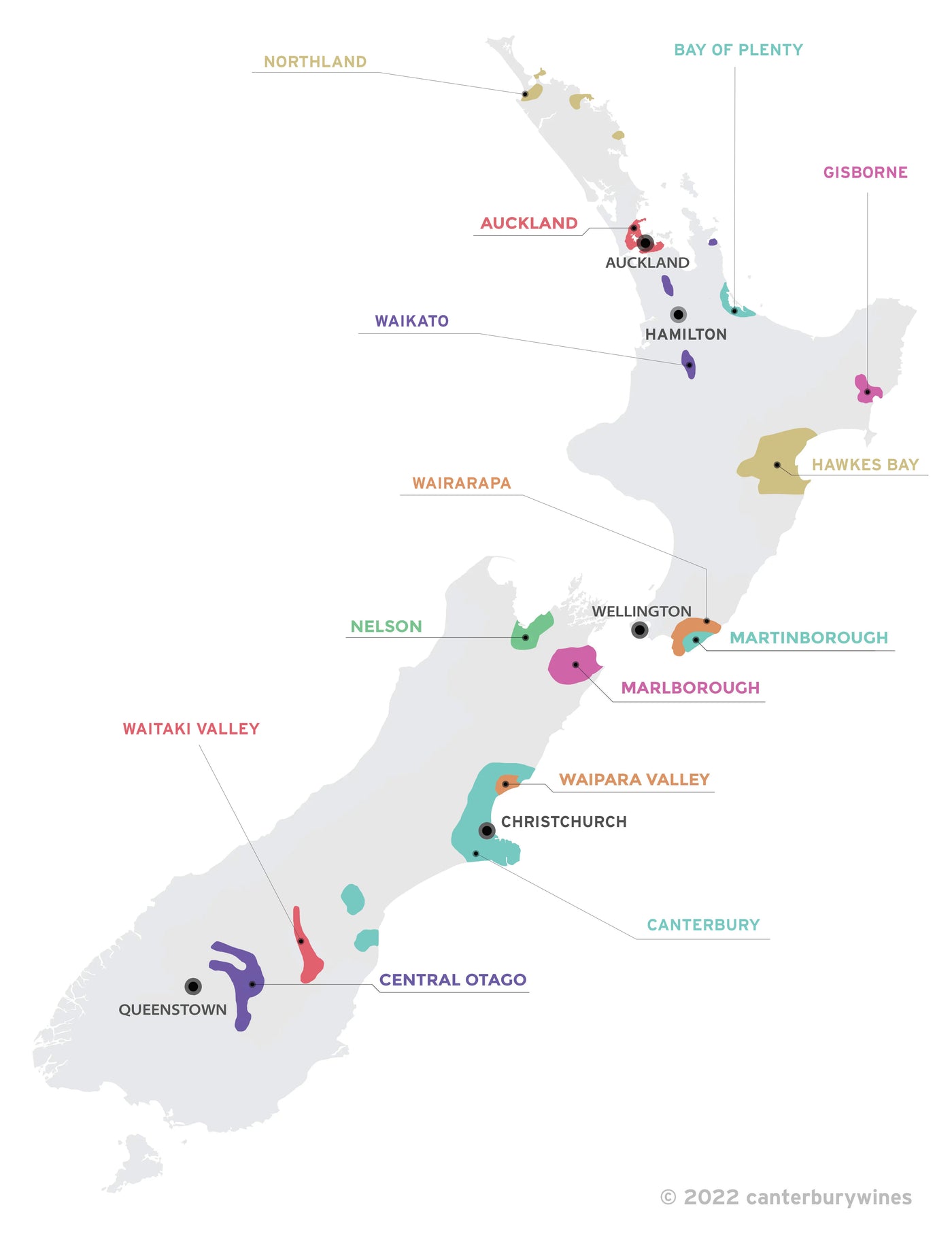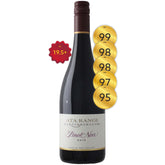

Ata Rangi Pinot Noir 2015
Style: Red Wine
Closure: Screwcap
Ata Rangi Pinot Noir 2015
Warehouse
34 Redland Drive
Vermont VIC 3133
Australia
Critic Score: 99 and 19.5/20
Alcohol: 13.5%
Size: 750 ml
Drink by: 2032
Ata Rangi, meaning 'dawn sky' or 'new beginning', is a small, family-owned, organic winery in Martinborough that has a reputation for producing exceptional quality pinot noir. The Ata Rangi Pinot Noir is their flagship wine and is regarded by many to be one of the greatest pinot noirs that comes out of New Zealand.
"The wine is full-bodied and intense, concentrated, powerful and yet also elegant and effortless. Delicious fruit sweetness and ripeness. A glorious pinot." Huon Hooke
"Full, very dark, deep, ruby-red colour with youthful purple hues, a little lighter on the rim. The nose is elegantly concentrated with a deep, dense core of well-ripened dark-red cherry and berry fruit seamlessly melded with subtle dark-red florals, dark herbs, spices and oak elements, unfolding black-berried fruits. The aromatics are exceptionally harmonious and integrated, and the nose is quite complete." Ata Rangi
Expert reviews
"Very seductive pinot noir combining a sensual, silken texture with layers of complex fruit and savoury flavours. The wine has structure but it is deeply buried within a core of sweet fruit. Dark-fleshed plum, violet, cherry, spice and very subtle fresh herbs are among the more obvious flavours in this supremely complex wine. Outstanding! Drink: 2017–2026." Bob Campbell MW, The Real Review - 99 points
"Medium-full bodied, the palate features rich and succulently sweet flavours of dark-red cherry and berry fruits along with black fruits lifted by dark-red and violet florals and subtle notes of dark herbs. Suggestions of spice and oak emerge. The flavours are beautifully precise, detailed and harmoniously balanced, and the mouthfeel very supple and fine-textured with flowery tannin extraction. The acidity is integrated and provides vitality for the refined core and line. The wine flows seamlessly to a long and sustained, complete finish. This is a beautifully rich and multi layered and detailed Pinot Noir of precision and harmony, with succulently sweet fruit and refined structure, enabling accessibility, and showing completeness. It will develop fine complexities over the next 7-10 years." Raymond Chan – 19.5+/20 points ★★★★★
"Deep red colour with a good purple tint. The bouquet is fresh and bright with dark cherry and dark plum aromas beneath a patina of polished timber, probably oak-derived. The wine is full-bodied and intense, concentrated, powerful and yet also elegant and effortless. Delicious fruit sweetness and ripeness. A glorious pinot, just starting to hit its straps and with many years ahead of it. Drink: 2019–2030." Huon Hooke, The Real Review - 98 points (Tasted Sep 2019)
"A symphonic offering, once again, exhibiting red/black cherry, mushroom, mixed spice and vanilla characters with nuances of black tea and floral on the nose. The palate is superbly structured and seductively expressed, offering lovely fruit purity together with sensual mouthfeel and savoury undertones. Perfectly proportioned and impeccably balanced, this is another super-star in the making. At its best: 2019 to 2030." Sam Kim - 98 points
"A complex and giving wine that was born of a low-yielding, dry vintage, this is testament to the character of these older vines. The nose carries a deep-set spiciness in the cinnamon and baking spice spectrum with plenty of ripe red plum, some red cherry and spiced plum pastry, too. There's a greater savory and spice emphasis this vintage. The palate has plenty of tannins, gently chewy and assertive, and it carries a core of tangy cherry pip-flavored fruit and nutty ripeness through the finish. Drink now and for some years to come." Nick Stock, JamesSuckling.com – 97 points
"Even better than I remember from last year, the 2015 Pinot Noir includes 40% whole clusters (about the usual proportion). It's floral and stemmy, then adds huge black cherry fruit and an ample dusting of complex spices. Medium to full-bodied, it's firm and tannic but not unapproachable, with a long, lip-smacking finish." Joe Czerwinski, Wine Advocate - 95 points (Tasted Mar 2019)
About martinborough
 Martinborough is one of the three sub-regions of the Wairarapa wine region in the southern part of New Zealand's North Island. It is world renowned and by far the most important sub-region (the other two being Gadstone and Masterton), so is considered here to be a region to avoid confusion.
Martinborough is one of the three sub-regions of the Wairarapa wine region in the southern part of New Zealand's North Island. It is world renowned and by far the most important sub-region (the other two being Gadstone and Masterton), so is considered here to be a region to avoid confusion.
The small, picturesque town of Martinborough and its surrounding district are home to some of New Zealand's most highly respected boutique wineries. Martinborough lies in a wide river valley between the Rimutaka mountain range and the eastern Wairarapa hills. The Ruamahanga River meanders through the region on its way to Palliser Bay, 32 kilometers to the south. The first vines were planted here by James Busby in 1838 when he was sent from England to collect samples of all grape varieties for potential introduction into Australia (he found that European vines did not grow well in Australia, but thrived in New Zealand's climate conditions). However, it was not until the 1970s that it was discovered as a prime site for viticulture. In 1978, a scientific report compared the climate of the region with that of Burgundy in France, and a few pioneering vignerons began to buy land around Martinborough and plant it with vines.
The viticultural focal point of the region is the Martinborough Terrace – a raised plateau of alluvial gravel just north of the town that has been forced up over time by tectonic movement. The free-draining nature of this soil is excellent for viticulture because it limits the hydration of the vines, leading to stress. These stressed vines put their energy more into producing small, concentrated berries than leafy foliage, increasing the quality of the grapes and subsequently the wines. Similar soils extend around this small area, notably further east, in the unoffical Te Muna sub-region. Vineyards can also be found further south of Martinborough although this region tends to be cooler with a more mixed soil makeup, often with slightly higher levels of clay.
Despite the fact that Martinborough has only three percent of all of New Zealand's vineyard land, it is still widely considered to be one of the country's prime wine regions. Its claim to fame is the exceptional quality of its Pinot Noir wines, produced by some of the most highly regarded wineries in New Zealand.
"Martinborough's reputation for producing high quality pinot has been known for almost as long as the region's existence, but it's a reputation that has seen extraordinary growth in recent times. 'When I came here in 1986 there were only four wine producers,' says McKenna, who to many is recognised as one of the region's father figures. 'Three of them are amongst the best that are still here', referring to Martinborough Vineyard, Ata Rangi and Dry River. 'It's fair to say,' he continues, 'that the combination of vine age and producers' experience with the district has certainly equated to a gradual increase in quality.' The pursuit of excellence is always top of mind, to which Ata Rangi winemaker Helen Masters attests. 'If I need something done, there's no question about cost, time, effort,' she says. 'We just make it happen.' The irony, as any visitor to the region is bound to hear, is that Martinborough contributes just one percent of New Zealand's annual grape crush but is home to 10 percent of the country's winemakers. If that's not saying something about the quality of the wine, what is?
The wines here are centered on a few key varieties, but unlike many other regions, are almost impossible to pigeonhole. Everything from the flat, free-draining gravel vineyards of the Martinborough terrace to the denser stony clay soils of Te Muna Road, the heavy focus on terroir, vintage, or clonal selection, or all of the above, results in a wealth of wine styles that share the common ground of elegance and richness and speak loudly of time and place.
Pinot noir is by far the region's hero – which typically, thanks to the region's climatic similarities to Burgundy, produces beautiful medium-bodied wines with dark plum fruit flavours and distinct savoury characters – followed closely by luscious pinot gris and mineral-like sauvignon blanc, as well as chardonnay, riesling, gewürztraminer and syrah.
The township was established in the late 1870s by John Martin, an Irish landowner whose patriotism for home remains evident in the Union Jack-shaped town square. However, the region's modern wine industry wasn't established until a century later after soil scientist Dr Derek Milne conducted a report that yielded the resemblance-to-Burgundy results. He subsequently founded Martinborough Vineyard; others soon followed suit and those four or five founding producers spawned a progressive farming community that lives and breathes the 'wine is made in the vineyard' philosophy. It's a special place." Dom Sweeney, Gourmet Traveller Wine
About the winery

Ata Rangi, meaning 'dawn sky' or 'new beginning', is a small, family-owned, organic winery in Martinborough that has a reputation for producing exceptional quality pinot noir. Ata Rangi was founded by Clive Paton in 1980. The first vines were planted on a small, stony sheep paddock at the edge of the Martinborough Village. Clive's sister Alison bought an adjoining block soon after and in 1986 Clive's partner Phyll Pattie bought a share in the business after moving from Marlborough where she had been working as a winemaker.
Today, 42 years on, Ata Rangi has an enviable reputation as one of the new world's most respected pinot noir producers. Alison Paton heads up the day-to-day running of the business, with Helen Masters crafting the wines aided by the vital stewardship of vineyard manager Braden Crosby.
Ata Rangi farms around 32 hectares, spread over 14 vineyards, that are clustered around the village of Martinborough. The sites feature the characteristic Martinborough Terrace profile of 300-600mm of shallow silt-loam overlaying 25-30 metre-deep alluvial gravels. The McCrone and Masters Vineyards are differentiated by a higher percentage of clay within the gravels.
Ata Rangi's home vineyards attained full organic status in 2014. Weeds are managed with under-vine weeding tools, with a combination of cultivation and mowing. The vineyards' biodiversity is enhanced by a mixture of native and exotic shelterbelts and inter-row wildflower planting that provide havens for native predatory and beneficial insects. Compost is made on-site from grape stalks, skins, and yeast lees, mixed with seaweed, forest floor duff and harvested green crops. This mix is utilised in the vineyard to make compost tea for vine health and boost organic matter within the soil.
Fruit is drawn from a diverse range of vineyards, each managed to suit its soil and clonal diversity. This individualised care, alongside the age of the original vines which are now reaching 40 years old, are both major factors in the quality and consistency of the wines from year to year. Spring is often cool and windy which reduces fruit set, so yields are naturally low. Summer days are consistently warm, though nights are generally cool. Autumn is often long and dry, perfect for hand harvesting.
The Ata Rangi winemaking philosophy is a simple, hands-off, traditional approach focused on finding the true expression of the place. They see wines from Martinborough as having a real depth of palate with texture and length. They aim for balance in all their wines, so use winemaking practices such as whole bunch and barrel ageing to ensure that vineyard expression remains the hero.
Each season brings its own unique growing conditions. Cooler vintages express more herbal and spicy notes, whereas a warmer season delivers fuller fruit aromas. Staying true to the vintage means the wines will express these features. They focus on harvesting at the point where ripeness is "optimum” i.e where sugar, tannin and acid intersect at a "just on the cusp of ripeness”, and tension and vibrancy of aroma are balanced with tannins.
Whole bunch inclusion plays a role in the fermentations of the pinot noir — the level of which varies according to site and vine age, which can be from 20 to 100% with the remainder de-stemmed. The fermentation that takes place within the whole berry along with the contact with the stems, lifts the aromas and gives a fine flow to the tannins.
Due to the close proximity to the South Pacific Ocean, the temperate climate results in an extended growing season, allowing the fruit to ripen slowly. This enables the tannins in the seeds and skin of the grapes to fully ripen. This is reflected in the Ata Rangi style, a backbone of fine tannins, supported by vibrant acidity which gives a structure to the wines that afford them real age-ability.

New Zealand
New Zealand is home to more than 700 wineries across 14 wine regions. The regions are Auckland, Bay of Plenty, Canterbury, Central Otago, Gisborne, Hawkes Bay, Marlborough, Martinborough*, Nelson, Northland, Waikato, Waipara Valley, Wairarapa and Waitaki Valley. * Martinborough is a sub-region of Wairarapa, however, as it is world renowned it is considered here to be a region to avoid confusion.
The wine regions in New Zealand stretch from latitudes 36°S (Northland) in the north (comparable in latitude to Jerez, Spain), to 45°S (Central Otago) in the south (comparable in latitude to Bordeaux, France). New Zealand's climate is maritime, producing cooler summers and milder winters than would be expected at similar latitudes in Europe.
Viticulture in New Zealand dates back to 1836 when British resident James Busby produced wine in the far north, but it wasn't until 1985 that the wine industry came of age when Cloudy Bay Sauvignon Blanc garnered international attention and critical acclaim.
New Zealand is internationally renowned for Sauvignon Blanc (particularly from Marlborough), Pinot Noir (Central Otago, Martinborough and Waipara Valley), Chardonnay, Bordeaux-style blends of mainly Merlot and Cabernet Sauvignon (Hawkes Bay) and Syrah (Hawkes Bay). Sauvignon Blanc accounts for 63% of the area of the national vineyard, followed by Pinot Noir (14%), Chardonnay (8%), Pinot Gris (7%) and Merlot (3%).

